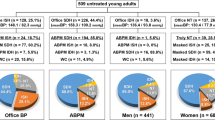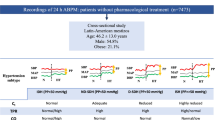Abstract
Introduction
Early detection of cardiovascular disease (CVD) in prehypertension could initiate appropriate treatment and prevent progression. Impedance cardiography (ICG) is a noninvasive technology that can be used to assess cardiovascular function.
Objective
This study used ICG waveform analysis with postural change to detect CVD in asymptomatic prehypertensive adults over 40 years of age with no history of CVD and at least 2 cardiovascular risk factors: cigarette smoking, poor diet, physical inactivity, central obesity, family history of premature CVD, elevated blood glucose, and dyslipidemia.
Methods
A study group of 25 apparently healthy adults was tested by ICG in standing and supine positions. Criteria for an age-matched control group of 16 healthy subjects included an active lifestyle, no risk factor, and no history of CVD. In addition to hemodynamic measurements of systemic vascular resistance (SVR) and cardiac index (CI), ICG used SVR to assess vascular resistive load, an index of arterial compliance and a widening of the systolic waveform to assess vascular pulsatile load, and waveform analysis and measured wave amplitude to detect ventricular dysfunction.
Results
All subjects in the study group had some abnormal ICG data, with an average of 2.9 ± 1.5 abnormalities per person. ICG indicated that 24 (96 %) had elevated vascular load, 13 (52%) had some type of ventricular dysfunction, and 12 (48 %) had abnormal hemodynamics. For the control group, ICG showed none (0 %) with elevated vascular load, none (0 %) with ventricular dysfunction, and 7 (44 %) with high CI.
Conclusions
Prehypertensives over 40 years of age with multiple risk factors have different cardiovascular abnormalities. This ICG test could be used as part of a prevention program for early detection of CVD. An abnormal ICG test could expedite the initiation of customized treatment that targets the subclinical CVD.



Similar content being viewed by others
References
Chobanian AV, Bakris GI, Black HR, Cushman WC, Green LA, Izzo JL Jr, Jones DW, Materson BJ, Oparil S, Wright JT Jr, Roccella EJ. The seventh report of the Joint National Committee on Prevention, Detection, Evaluation and Treatment of High Blood Pressure. JAMA. 2003;289:2560–72.
Wang Y, Wang QJ. The prevalence of prehypertension and hypertension among US adults according to the new joint national committee guidelines: new challenges of the old problem. Arch Intern Med. 2004;164:2126–34.
Vasan RS, Larson MG, Leip EP, Evans JC, O’Donnell CJ, Kannel WB, Levy D. Impact of high-normal blood pressure on the risk of cardiovascular disease. N Engl J Med. 2001;345:1291–7.
Qureshi AI, Suri MF, Kirmani JF, Divani AA, Mohammad Y. Is prehypertension a risk factor for cardiovascular disease? Stroke. 2005;36:1859–63.
Liszka HA, Mainous AG III, King DE, Everett CJ, Egan BM. Prehypertension and cardiovascular mortality. Ann Fam Med. 2005;3:294–9.
Kshirsagar AV, Carpenter M, Bang H, Wyatt SB, Colindres RE. Blood pressure usually considered normal is associated with an elevated risk of cardiovascular disease. Am J Med. 2006;119:133–41.
Greenlund KJ, Croft JB, Mensah GA. Prevalence of heart disease and stroke risk factors in persons with prehypertension in the United States, 1999–2000. Arch Intern Med. 2004;164:2113–8.
Vasan RS, Larson MG, Leip EP, Kannel WB, Levy D. Assessment of frequency of progression to hypertension in non-hypertensive participants in the Framingham Heart Study: a cohort study. Lancet. 2001;358:1682–6.
Vasan RS, Beiser A, Seshadri S, Larson MG, Kannel WB, D’Agostino RB, Levy D. Residual lifetime risk for developing hypertension in middle-aged women and men: the Framingham Heart Study. JAMA. 2002;287:1003–10.
Parikh NI, Pencina MJ, Wang TJ, Benjamin EJ, Lanier KJ, Levy D, D’Agostino RB Sr, Kannel WB, Vasan RS. A risk score for predicting near-term incidence of hypertension: the Framingham Heart Study. Ann Intern Med. 2008;148:102–10.
Kshirsagar AV, Chiu Y, Bomback AS, August PA, Viera AJ, Colindres RE, Bang H. A hypertension risk score for middle-aged and older adults. J Clin Hypertens (Greenwich). 2010;12:800–8.
Mancia G, De Backer G, Dominiczak A, Cifkova R, Fagard R, Germano G, Grassi G, Heagerty AM, Kjeldsen SE, Laurent S, Narkiewicz K, Ruilope L, Rynkiewicz A, Schmieder RE, Struijker Boudier HA, Zanchetti A. ESH-ESC Guidelines for the management of arterial hypertension: the task force for the management of arterial hypertension of the European Society of Hypertension (ESH) and of the European Society of Cardiology (ESC). Blood Press. 2007;2007(16):135–232.
National Health Committee. Guidelines for the Management of Mildly Raised Blood Pressure in New Zealand. Wellington: New Zealand Ministry of Health; 1995.
McDonagh TA, Morrison CE, Lawrence A, Ford I, Tunstall-Pedoe H, McMurray JJ, Dargie HJ. Symptomatic and asymptomatic left-ventricular systolic dysfunction in an urban population. Lancet. 1997;350:829–33.
Redfield MM, Jacobsen SJ, Burnett JC, Mahoney DW, Bailey KR, Rodeheffer RJ. Burden of systolic and diastolic LV dysfunction in the community. JAMA. 2003;289:194–202.
Bernstein DP. A new stroke volume equation for thoracic electrical bioimpedance: theory and rationale. Crit Care Med. 1986;14:904–9.
Yancy C, Abraham WT. Noninvasive hemodynamic monitoring in heart failure: utilization of impedance cardiography. Congest Heart Fail. 2003;9:241–50.
DeMarzo AP. Using impedance cardiography with postural change to stratify patients with hypertension. Ther Adv Cardiovasc Dis. 2011;5(3):139–48.
DeMarzo AP, Calvin JE, Kelly RF, Stamos TD. Using impedance cardiography to assess left ventricular systolic function via postural change in patients with heart failure. Prog Cardiovasc Nurs. 2005;20(4):163–7.
DeMarzo AP, Calvin JE. A new approach for low-cost noninvasive detection of asymptomatic heart disease at rest. Prev Cardiol. 2007;10:9–14.
Kubicek WG. On the source of peak first time derivative (dZ/dt) during impedance cardiography. Ann Biomed Eng. 1989;17:459–62.
Buell JC. A practical, cost-effective, noninvasive system for cardiac output and hemodynamic analysis. Am Heart J. 1988;116:657–64.
Richards NT, McBrien DJ. Changes in the impedance cardiogram occurring with change in posture in patients with heart disease. Int J Cardiol. 1988;20:365–72.
Braunwald E, Fauci AS, Kasper DL, Hauser SL, Longo DL, Jameson JL, editors. Harrison’s principles of internal medicine. 15th ed. New York: McGraw-Hill; 2001. p. 1312–1313.
Ooi H, Chung W, Biolo A. Arterial stiffness and vascular load in heart failure. Congest Heart Fail. 2008;14:31–6.
Abdelhammed AI, Smith RD, Levy P, Smits GJ, Ferrario CM. Noninvasive hemodynamic profiles in hypertensive subjects. Am J Hypertens. 2005;18:51S–9S.
Glasser SP, Arnett DK, McVeigh GE, Finkelstein SM, Bank AJ, Morgan DJ, Cohn JN. Vascular compliance and cardiovascular disease: a risk factor or a marker? Am J Hypertens. 1997;10:1175–89.
Liao D, Arnett DK, Tyroler HA, Riley WA, Chambless LE, Szklo M, Heiss G. Arterial stiffness and the development of hypertension the ARIC study. Hypertension. 1999;34:201–6.
Resnick LM, Militianu D, Cunnings AJ, Pipe JG, Evelhoch JL, Soulen RL, Lester MA. Pulse waveform analysis of arterial compliance: relation to other techniques, age, and metabolic variables. Am J Hypertens. 2000;13:1243–9.
Hunt SA, Abraham WT, Chin MH, Feldman AM, Francis GS, Ganiats TG, Jessup M, Konstam MA, Mancini DM, Michl K, Oates JA, Rahko PS, Silver MA, Stevenson LW, Yancy CW, Antman EM, Smith SC Jr, Adams CD, Anderson JL, Faxon DP, Fuster V, Halperin JL, Hiratzka LF, Jacobs AK, Nishimura R, Ornato JP, Page RL, Riegel B. ACC/AHA 2005 guideline update for the diagnosis and management of chronic heart failure in the adult: a report of the American College of Cardiology/American Heart Association Task Force on Practice Guidelines (Writing Committee to Update the 2001 Guidelines for the Evaluation and Management of Heart Failure): developed in collaboration with the American College of Chest Physicians and the International Society for Heart and Lung Transplantation: endorsed by the Heart Rhythm Society. Circulation. 2005;112:e154–235.
Berry JD, Dyer A, Cai X, Garside DB, Ning H, Thomas A, Greenland P, Van Horn L, Tracy RP, Lloyd-Jones DM. Lifetime risks of cardiovascular disease. N Engl J Med. 2012;366:321–9.
Mancia G, Laurent S, Agabiti-Rosei E, Ambrosioni E, Burnier M, Caulfield MJ, Cifkova R, Clément D, Coca A, Dominiczak A, Erdine S, Fagard R, Farsang C, Grassi G, Haller H, Heagerty A, Kjeldsen SE, Kiowski W, Mallion JM, Manolis A, Narkiewicz K, Nilsson P, Olsen MH, Rahn KH, Redon J, Rodicio J, Ruilope L, Schmieder RE, Struijker-Boudier HA, van Zwieten PA, Viigimaa M, Zanchetti A. Reappraisal of European guidelines on hypertension management: a European Society of Hypertension Task Force document. J Hypertens. 2009;27:2121–58.
Conflict of interest
The author reports that there is no specific funding in relation to this research. A potential conflict of interest is that the author is an employee of the company, which manufactured the impedance cardiograph used in this research.
Author information
Authors and Affiliations
Corresponding author
Rights and permissions
About this article
Cite this article
DeMarzo, A.P. Using Impedance Cardiography to Detect Asymptomatic Cardiovascular Disease in Prehypertensive Adults with Risk Factors. High Blood Press Cardiovasc Prev 20, 61–67 (2013). https://doi.org/10.1007/s40292-013-0009-0
Received:
Accepted:
Published:
Issue Date:
DOI: https://doi.org/10.1007/s40292-013-0009-0




